Ancient Light Photowalk, Malleswaram, Bangalore 010810 Part 1 KAdu MallEswarA Temple
August 10, 2010
Here’s
that I wrote for Citizen Matters, about the photowalk. That gives the background to how and why I organized the walk. But obviously, the article could not use many photographs…or my thoughts about the walk….
Most of the heritage walks that I’ve been on, in this city of mine, are photowalks, as there are several people who like to document the sights. I certainly enjoyed documenting the walks at
and so on and on….but here I’m not restricted, so….
 Let me use the title photograph again....it's one of my favourites, "illuminating" the concept of ancient light, as typified by a brass lamp that's been a form of illumination for centuries!
Let me use the title photograph again....it's one of my favourites, "illuminating" the concept of ancient light, as typified by a brass lamp that's been a form of illumination for centuries!
 Here's the sign declaring the kAdu mallEswarA temple a protected monument:
Here's the sign declaring the kAdu mallEswarA temple a protected monument:
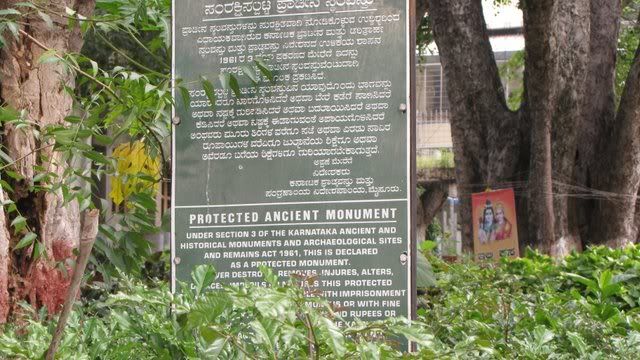 The temple has been renovated, and the grounds prettified...but the steps still have a grandeur of their own, in the green surroundings.
The temple has been renovated, and the grounds prettified...but the steps still have a grandeur of their own, in the green surroundings.
 Here's part of the entrance archway.
Here's part of the entrance archway.
 What really impressed me were also the majestic, ancient trees in the temple complex:
What really impressed me were also the majestic, ancient trees in the temple complex:
 Chandu also spotted this
SPOTTED OWLET
in the huge Peepal tree!
Chandu also spotted this
SPOTTED OWLET
in the huge Peepal tree!
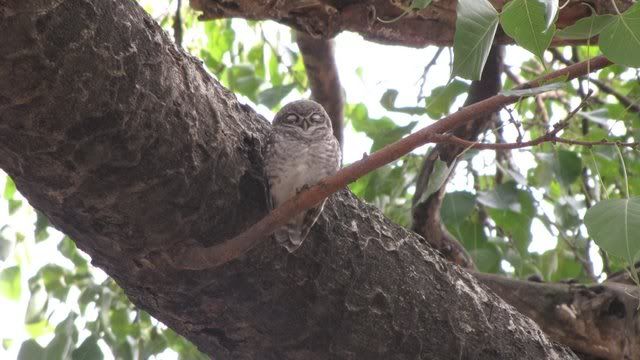 There's a large figure of
SeshA, the divine serpent. ShivA is "nAgAbhooshaNA", one who is adorned by a snake, and the snake motif prevails in Shiva temples:
There's a large figure of
SeshA, the divine serpent. ShivA is "nAgAbhooshaNA", one who is adorned by a snake, and the snake motif prevails in Shiva temples:
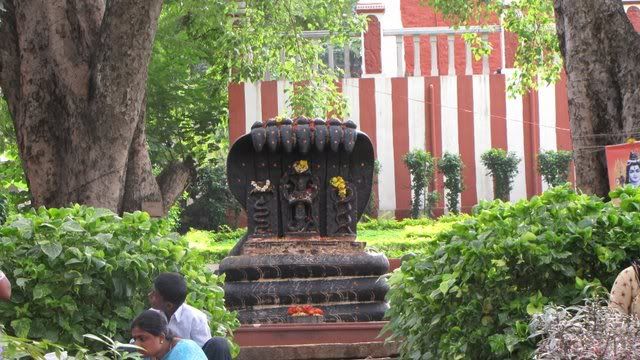 It was good to document the various parts of the temple, as well, as the photographers themselves. Here's one, framed as he frames the temple in his lens:
It was good to document the various parts of the temple, as well, as the photographers themselves. Here's one, framed as he frames the temple in his lens:
 It was intriguing to try and work out which were the really old parts of the temples, and which had been added later. I think the gOpurA was not a very old part of the temple, but I liked the statue of this
nAga kannikA (snake maiden):
It was intriguing to try and work out which were the really old parts of the temples, and which had been added later. I think the gOpurA was not a very old part of the temple, but I liked the statue of this
nAga kannikA (snake maiden):
 Everywhere there were signs drawing our attention to what was morally acceptable and therefore, spiritually good for us. I don't know if such exhortations do make better mortals of the visitors:
Everywhere there were signs drawing our attention to what was morally acceptable and therefore, spiritually good for us. I don't know if such exhortations do make better mortals of the visitors:
 (Translation:"When a man's inner strength is expressed.. it's a good deed...when a man's strength is abused... it's a bad deed")
The saptha kalashA, or seven sacred pots (filled with waters from the great rivers such as Ganga, Yamuna, Narmada, and Kaveri) set at the top of the gOpurA, shone in the evening sun. There was a fascinating play of light and shadow, with the sun shining through one minute, and hidden behind monsoon clouds the next.
(Translation:"When a man's inner strength is expressed.. it's a good deed...when a man's strength is abused... it's a bad deed")
The saptha kalashA, or seven sacred pots (filled with waters from the great rivers such as Ganga, Yamuna, Narmada, and Kaveri) set at the top of the gOpurA, shone in the evening sun. There was a fascinating play of light and shadow, with the sun shining through one minute, and hidden behind monsoon clouds the next.
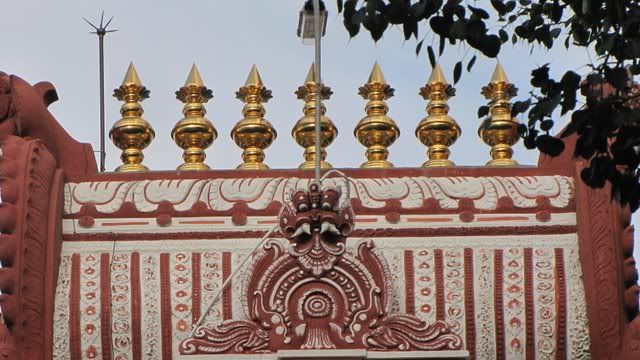 If I'd been so inclined, I'd have drawn a parallel between this alternating light and shadow, and the joys and sorrows in human lives!
Many devotees have donated granite slabs of nAga dEvathAs, and they are stored in serried ranks:
If I'd been so inclined, I'd have drawn a parallel between this alternating light and shadow, and the joys and sorrows in human lives!
Many devotees have donated granite slabs of nAga dEvathAs, and they are stored in serried ranks:
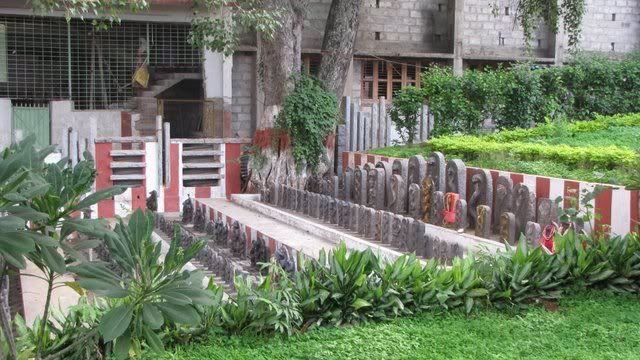 This signboard amused me, because it places responsibility for footwear on the devotee, but the temple's message is to place all responsibility at the feet of the Lord!
This signboard amused me, because it places responsibility for footwear on the devotee, but the temple's message is to place all responsibility at the feet of the Lord!
 This small nAga lingam, under another small tree, looked very beautiful:
This small nAga lingam, under another small tree, looked very beautiful:
 In the inner precincts of the temple, the priest's panchakachAs were drying. When washed, and then dried without being touched, they beome "pure" and ready for use during worship. We call this "madi" in Tamizh.
In the inner precincts of the temple, the priest's panchakachAs were drying. When washed, and then dried without being touched, they beome "pure" and ready for use during worship. We call this "madi" in Tamizh.
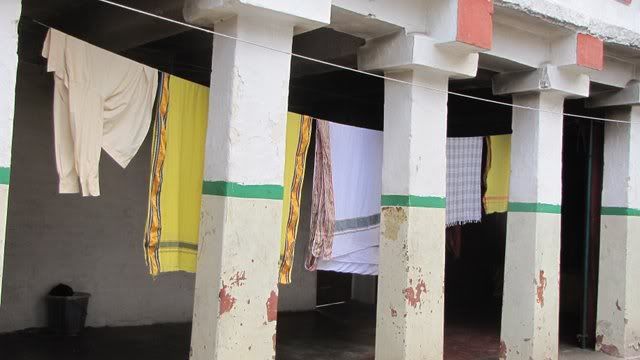 The list of charges for different forms of worship go all the way from cheap to expensive:
The list of charges for different forms of worship go all the way from cheap to expensive:
 Another metaphor that occurred to me was that of creation, being, and dissolution, the three states of the world, as symbolized by BrahmA, VishNu and ShivA....this "half basket" is in being now...but is it in the process of being created, or being destroyed?
Another metaphor that occurred to me was that of creation, being, and dissolution, the three states of the world, as symbolized by BrahmA, VishNu and ShivA....this "half basket" is in being now...but is it in the process of being created, or being destroyed?
 Light, in the form of votive lamps, is to be found everywhere in temples. Here, lemons are squeezed out, and then the skins turned inside out to make lamps:
Light, in the form of votive lamps, is to be found everywhere in temples. Here, lemons are squeezed out, and then the skins turned inside out to make lamps:
 These earthen lamps were lit at the base of another shrine:
These earthen lamps were lit at the base of another shrine:
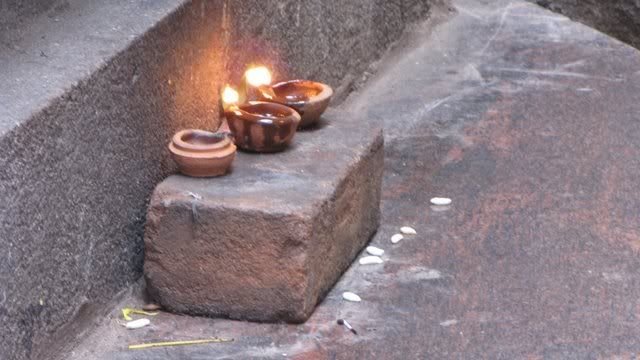 More offerings are accompanied by more oil lamps:
More offerings are accompanied by more oil lamps:
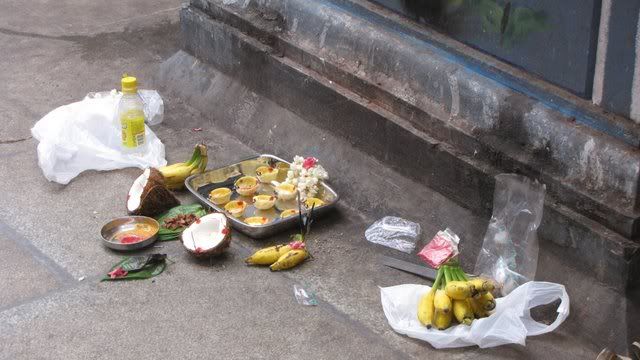 The shrines are dedicated to various gods. The garbha grahA, or the main shrine, is that of MallEswarA, the god of wrestling. ("malyuddhA" is combat in the form of wrestling, and kings, too, took pride in being proficient in this form....refer to "mAmallapuram" (city of the great wrestler)...another name for Mahabalipuram near Chennai. The PallavA king was called "mA mallan", a honorific title recognizing his wrestling prowess.
The shrines are dedicated to various gods. The garbha grahA, or the main shrine, is that of MallEswarA, the god of wrestling. ("malyuddhA" is combat in the form of wrestling, and kings, too, took pride in being proficient in this form....refer to "mAmallapuram" (city of the great wrestler)...another name for Mahabalipuram near Chennai. The PallavA king was called "mA mallan", a honorific title recognizing his wrestling prowess.
 Here's a shrine dedicated to the trinity of Goddesses (the wives of the trinity of Gods)....DurgA, Lakshmi, and Saraswathi...the goddesses of power, wealth and learning, respectively.
Here's a shrine dedicated to the trinity of Goddesses (the wives of the trinity of Gods)....DurgA, Lakshmi, and Saraswathi...the goddesses of power, wealth and learning, respectively.
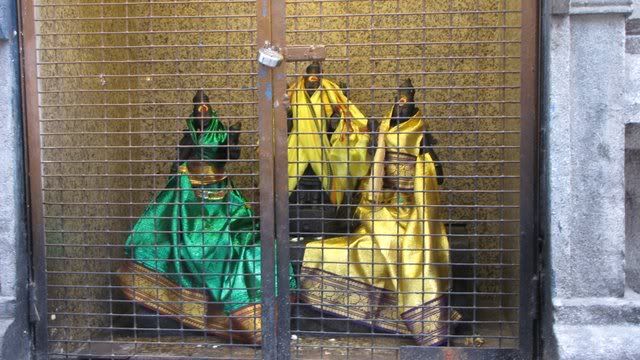 This is the shrine of pArvathi, ("daughter of the mountain")
This is the shrine of pArvathi, ("daughter of the mountain")
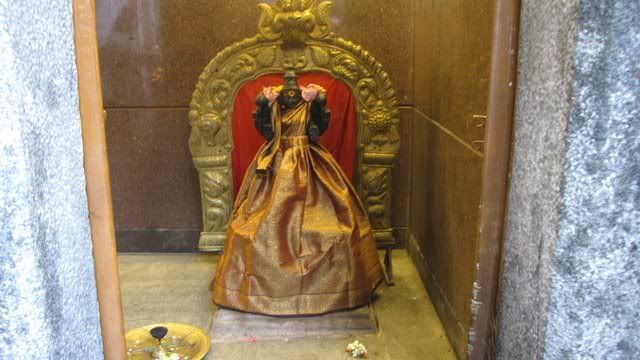 this one is that of AnjanEyA ("son of Anjana")
this one is that of AnjanEyA ("son of Anjana")
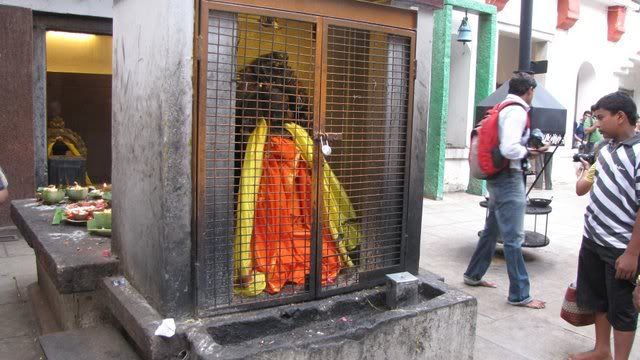 The temple's dhwaja sthambhA, or flag pole, is a beautifully stylized erection:
The temple's dhwaja sthambhA, or flag pole, is a beautifully stylized erection:
 Here's the detail of the base:
Here's the detail of the base:
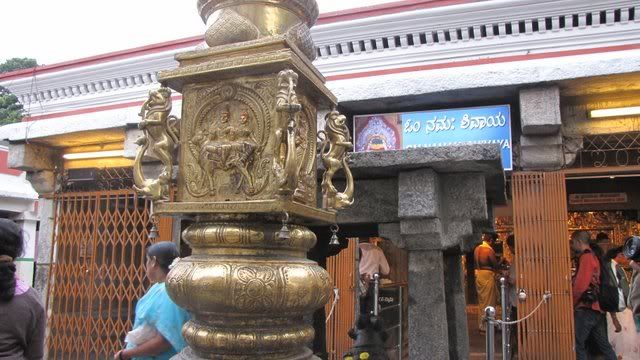 The brass work is very beautiful:
The brass work is very beautiful:
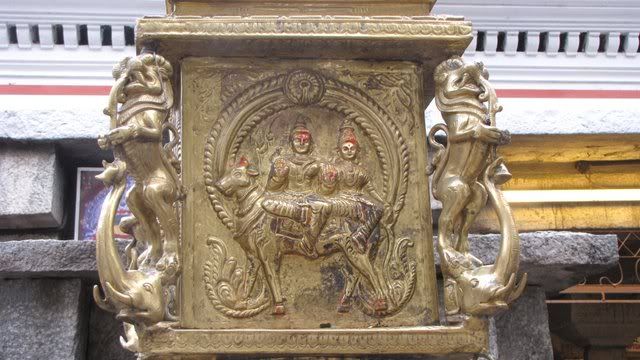 As I came out, I spotted this tableau on the neighbouring gOpurA, and was rather intrigued:
As I came out, I spotted this tableau on the neighbouring gOpurA, and was rather intrigued:
 ...because the tale it depicts is a typically Tamizh one...that of Avvai, the archetypal old dame of Tamizh letters, receiving the "gyAna pazham" (fruit of wisdom) from MurugA, the younger son of ShivA.
Avvai is carrying quite a hep shoulder-bag, and she's obviously a good trekker, with that stout stick!
Another thing that intrigued me was that even in a temple which is supposed to prevent devotees from all negativity, there was a "bhootha mukhA" (demon face) to ward off the evil eye:
...because the tale it depicts is a typically Tamizh one...that of Avvai, the archetypal old dame of Tamizh letters, receiving the "gyAna pazham" (fruit of wisdom) from MurugA, the younger son of ShivA.
Avvai is carrying quite a hep shoulder-bag, and she's obviously a good trekker, with that stout stick!
Another thing that intrigued me was that even in a temple which is supposed to prevent devotees from all negativity, there was a "bhootha mukhA" (demon face) to ward off the evil eye:
 The kAdu mallEswarA temple seems actually to be a complex of four temples: the MalleswarA, the Lakshmi NarasimhA, the NandeeswarA, and the GangammA (mother Ganges):
The kAdu mallEswarA temple seems actually to be a complex of four temples: the MalleswarA, the Lakshmi NarasimhA, the NandeeswarA, and the GangammA (mother Ganges):

Here are some of us, walking to the NandeeswarA TeerthA, which I will devote the next post to:
